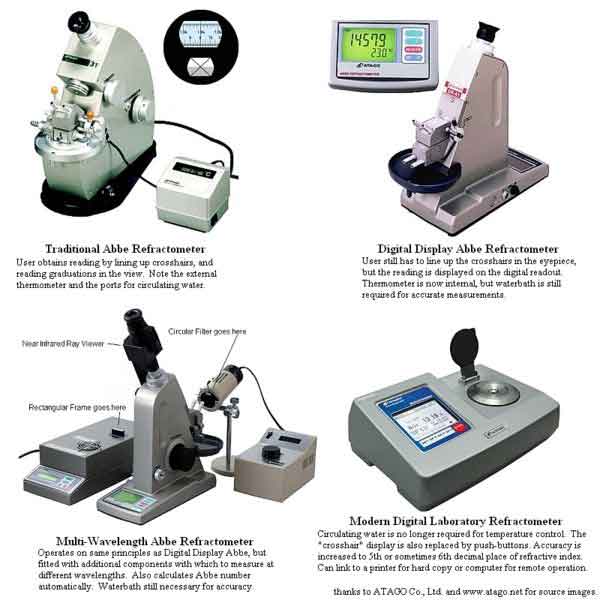.
Abbe refractometer

An illustration of the main types of laboratory refractometers in operation today.
An Abbe or laboratory refractometer is a bench-top refractometer that offer the highest precision of the different types of refractometers. Nearly a century and a half after their introduction, refractometers have come a long way in terms of usefulness, though their principle of operation has changed very little.
Ernst Abbe, working for the Zeiss Company in Jena, Germany in the late 1800s, was the first to develop a laboratory refractometer. These first instruments had built-in thermometers and required circulating water to control instrument and fluid temperatures. They also had adjustments for eliminating the effects of dispersion. These first instruments had analog scales from which the readings were taken.
There have been many refinements regarding ease of use and precision to these instruments over the decades, but they still operate on the same principle. They are still used today as an inexpensive alternative to digital laboratory refractometers. They are also possibly the easiest method to find the refractive index of solid samples, such as glass, plastics, and polymer films. Some Abbe refractometers utilize a digital display for the measurement, to eliminate the need for discerning between small graduations. The user still has to adjust the view to obtain the reading, however.
The first truly digital laboratory refractometers began appearing in the late 1970s and early 1980s, and no longer depended on the user's eye to determine the reading. They still required the use of circulating water baths to control instrument and fluid temperature. They did, however, have the ability to electronically compensate for the temperature differences of many fluids where there is a known concentration to refractive index conversion. Most digital laboratory refractometers, while much more accurate and versatile than their analog Abbe counterparts, are not capable of reading solid samples.
In the late 1990s, Abbe refractometers with the capability to read at wavelengths other than the standard 589 nanometers became available. These instruments utilize special filters of the desired wavelength of light, well into the near infrared (though a special viewer is required to see the infrared rays). Multi-wavelength Abbe refractometers can be used to very easily determine a sample's Abbe number.
The most advanced instruments of today use solid-state Peltier effect devices to heat and cool the instrument and the sample, eliminating the dependence on an external water bath. The software on most of the current instruments is now very advanced and offers features such as programmable user-defined scales and a history function that recalls the last several measurements. Several manufacturers provide easily usable controls, with the capability to operate from and export readings to a linked computer.
Retrieved from "http://en.wikipedia.org/"
All text is available under the terms of the GNU Free Documentation License

